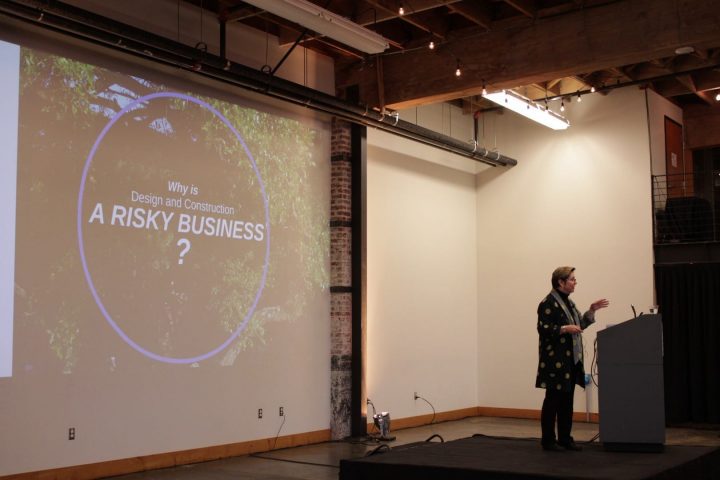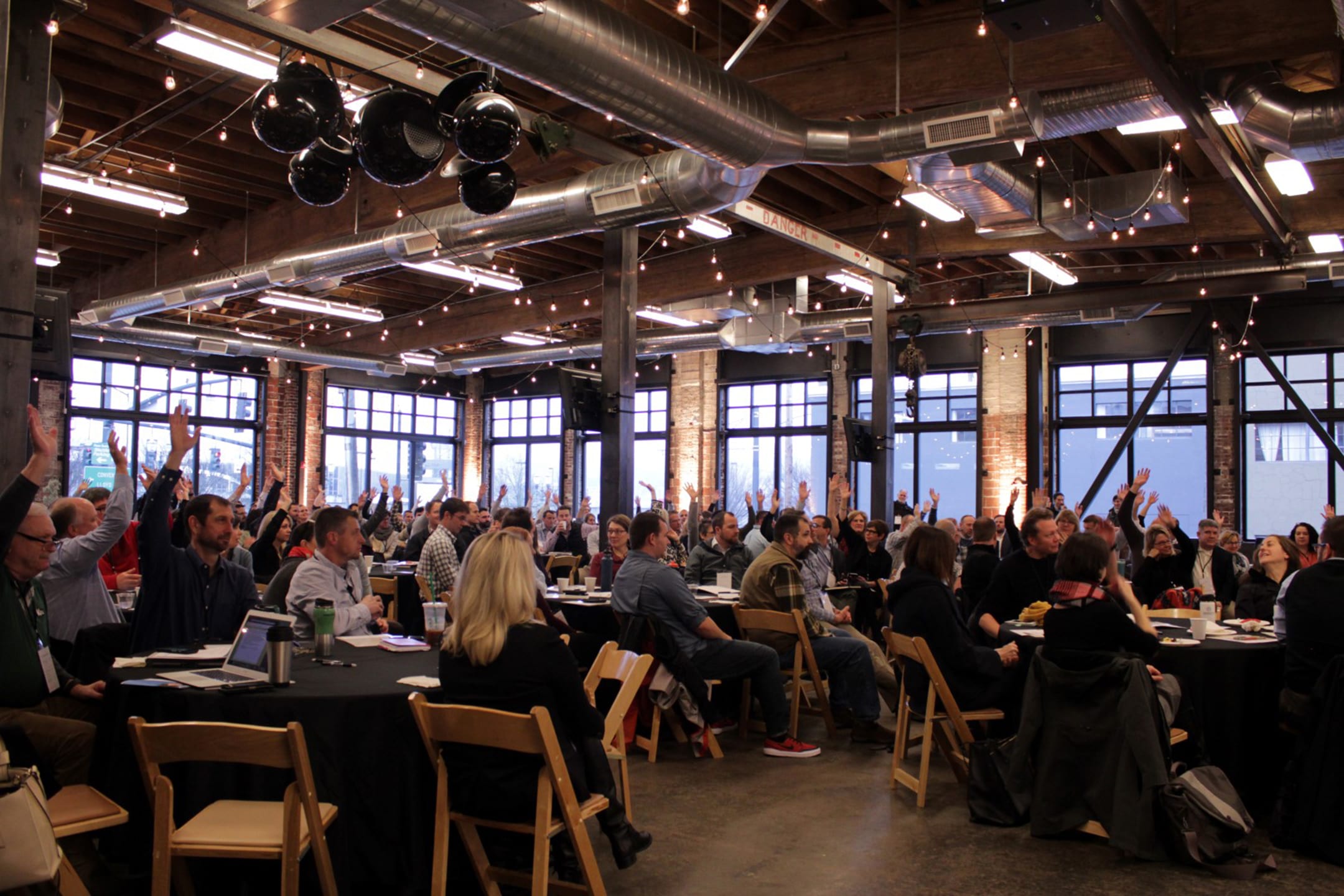 By Jules Rogers
By Jules Rogers
More than 200 contractors, architects and owners gathered last week at the Leftbank Annex at a symposium designed to address collaborative practices in the broad industry.
The Design and Construction Best Practices Symposium was put on for the fifth year by nonprofit Seek Change, founded in Portland.
Mike Buckiewicz, design and construction project manager at OHSU, also took care of marketing and communications for Seek Change’s symposium.
“This is a new group, a grassroots effort. We call ourselves Seek Change, but being a part of the group is about the experience,” Buckiewicz said. “Seek Change looks for progressive improvement. Each member looks to improve themselves in order to be at the center of change.”
Sponsors of the symposium include Cherry City Electric, The McCarthy/Andersen joint venture, Mortenson Construction, Skanska USA Building and TVA Architects.
Seek Change’s mission
Gary Hartill, president of Seek Change and president of Orangewall Studios architecture and planning, said he’s excited about this year’s symposium because of what he saw last year.
“At the end of the last symposium, a group of people realized something happened: the same group of people kept showing up to learn and grow together as a community and wanted to continue to build on the passion and desire to learn more how to work together,” Hartill said. “When we work in isolation we never realize true collaboration. Sitting across from someone saying, ‘how do we solve this problem,’ that’s a really powerful moment.”
Rather than just having an educational symposium, Hartill saw a need for a vehicle to propel Seek Change further, so his team formed the 501(c)(3) to improve delivery of construction projects in the local market, and become an example for others.
“We recognize we have to change our behaviors in order to accomplish this goal,” Hartill said. “We want everyone involved to be more successful financially and also personally. The values behind Seek Change are what really drive us — it’s not just contractual, it’s how we agree to behave when we show up at the table.”
Seek Change has expanded, too: it’s not just in Portland anymore, but also in Denver, Colorado.
“Our values are building blocks: humility, honesty, courage, trust and vulnerability. If any of you haven’t been in a room when you’re trying to be vulnerable, trying to have humility when a problem arises, it takes courage and trust to build true collaboration,” Hartill said. “That’s really our cornerstones of building true behavioral change. Driving those values is our goal.”
Who’s here
Jeff Boyd, senior estimator with JH Kelly, came to the symposium with his colleague Jason Shaw, senior project manager. Boyd is working as a subcontractor on the Knight Cancer Research Building, and Shaw is working on the CHH South building, both OHSU projects in the South Waterfront District.
“They’re really great events. You get to interact with a lot of your peers and a lot of different people involved in not only this project, but similar projects which is nice,” Shaw said. “Typically the speakers are really good and on point for things that are trending in the industry, so those are always exciting to listen to.”
JH Kelly is an industrial construction, commercial mechanical and pipe fabrication company that works all over the Pacific Northwest. Shaw told the Business Tribune he’s attended the symposium a few times before.
“The breakout sessions are really good because you have a lot of interaction with different people are different levels, not just the peer level but owners, contractors, subcontractors, a whole bunch of different aspects of our industry as well as architects and engineers,” Shaw said. “It’s a good mix of everybody we get to interact with, and not a lot of events do that so it’s pretty cool.”
Debbie Hutchins, an attendee from Skanska, is the director of business development. She’s only been there for three months, previously working at Portland State University as the director of development.
“Now I’m ready to use my network for profit,” Hutchins said. “The hope is I’ll bring a different perspective and different markets.”
Risky industry
Barbara White Bryson was one of two keynote speakers at the symposium. She’s a member of the College of Fellows of the American Institute of Architecture, is a senior fellow of the Design Futures Council, and currently resides as interim associate dean of Research and Academic Affairs at the College of Architecture, Planning and Landscape Architecture at the University of Arizona.
Her speech addressed new ways to approach the concept of riskiness with partners on a project.

“Risk is the most misunderstood word in our industry, a word that is often defined by insurers and lawyers,” Bryson said. “Architects and owners have been listening to these two groups of folks for too long about the definition of risk, and they have pushed us into an environment of risk avoidance that has been disastrous.”
She said risk is a much simpler concept than how many lawyers or insurers approach it.
“The dictionary says risk is exposure to the chance of injury or loss, a hazard or dangerous chance, and when you’re in the insurance world it defines risk as the degree of probability of such loss,” Bryson said. “The important concept here is that risk can be measured. It’s measured all the time, estimated all the time in the context of insurance. The important thing for you to remember about that is that measurement has no bearing for you — throw that away.”
In the project management world, risk is comprised of two elements: things you don’t know, and things you don’t control.
“Unpredictable outcomes are the product of unidentified risk, of those things you do not control and of those things you do not know,” Bryson said. “Predictable outcomes give us power to decide what we want and how we will get there — predictable outcomes permit us to innovate effectively.”
The path to predictable outcomes is understanding and managing risk, which allows control in going after those two elements and changes the conversation with other team members and partners on a project.
“How many times have you uttered the word ‘best practices’ and found people just go dark?” Bryson said. “Legislators don’t care. Board members don’t care about best practices, but if you start talking about reducing risk and managing risk, you can demonstrate you’re having a whole different conversation about why processes that you already know are effective are the right processes.”
She said timely decision-making removes risk from projects, and can be used as a management tool to keep the project on time, in communication and on budget.
“You’re going to have to have subcontractors who are willing to model and predict and give you information in real time,” Bryson said. “You’re going to have to have scoping information that’s very detailed, designers who are willing to have information ready, effective analysis tools that allow you to see what changes are based on information.”
When one team adds something to the budget, Bryson’s owners team would approve it and make sure something else was taken out to keep it all balanced.
It’s similar to the process already being used by the Knight Cancer Research Building team in its co-location trailer.
“On collaborative projects when you get everybody at the table day one and you trust them, you get to talk about the processes, you get to problem-solve collaboratively, you get to incorporate knowledge and market pressures early,” Bryson said. “Without the development of foundational knowledge, a knowledge base that can prove the value of buildings or processes, of design, of architecture are likely to be considered irrelevant within the next decade or so. Resources are becoming too dear; risk is too high; the impact to the economy, to the climate, to the future, is too great.”
Bryson said the future of architectural careers depends on the collaborative creation of knowledge.
“It’s time to invest in foundational research in our universities and share the information that you have tucked away in your firms and companies because we remain the only trillion-dollar industry in the history of the world,” Bryson said.
___________________________
The Seek Change Board
Tim Baugus, Skanska Construction
Mandy Butler, TVA architects
CiCi Ross, OHSU
Charlene Happel, OHSU
Mike Buckiewicz, OHSU
Matt Braun, JEDunn
Stefanie Becker, McCarthy
Kyle Majchrowski, Banner health, who runs the Denver symposium
